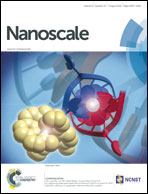Nanosized LiFePO4-decorated emulsion-templated carbon foam for 3D micro batteries: a study of structure and electrochemical performance†
Abstract
In this article, we report a novel 3D composite cathode fabricated from LiFePO4 nanoparticles deposited conformally on emulsion-templated carbon foam by a sol–gel method. The carbon foam is synthesized via a facile and scalable method which involves the carbonization of a high internal phase emulsion (polyHIPE) polymer template. Various techniques (XRD, SEM, TEM and electrochemical methods) are used to fully characterize the porous electrode and confirm the distribution and morphology of the cathode active material. The major benefits of the carbon foam used in our work are closely connected with its high surface area and the plenty of space suitable for sequential coating with battery components. After coating with a cathode material (LiFePO4 nanoparticles), the 3D electrode presents a hierarchically structured electrode in which a porous layer of the cathode material is deposited on the rigid and bicontinuous carbon foam. The composite electrodes exhibit impressive cyclability and rate performance at different current densities affirming their importance as viable power sources in miniature devices. Footprint area capacities of 1.72 mA h cm−2 at 0.1 mA cm−2 (lowest rate) and 1.1 mA h cm−2 at 6 mA cm−2 (highest rate) are obtained when the cells are cycled in the range 2.8 to 4.0 V vs. lithium.


 Please wait while we load your content...
Please wait while we load your content...